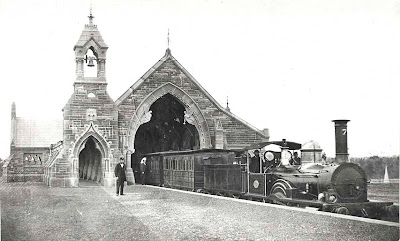- Sydney businesswomen in the 1790s
- Our earliest known film
- 6000-year-old discovery in Alexandria
- Tamarama rollercoaster
- The mortuary train
- Sydney’s (unofficial) queen
- Our hidden lake
- The man who was hanged on Fort Denison
- “Professor” Parker, the “champion of Australia”
- Coffee Culture
One of the earliest female business owners in Sydney was an Irish convict called Jane Maher. She was one of a handful of licensed bakers in Sydney in 1799. Jane’s “Bakehouse on the Rocks” was situated between Lang, Grosvenor and York Streets in the city. Her partner, Edward Turley, also an Irish convict, ran a sly grog shop ‘round the back of the house. Their trades before transportation? He was a highwayman, she was a madam of a brothel. (Both are Cassie Mercer’s GGGGG grandparents).
2. Our earliest short film: Le Patineur Grotesque
Australia’s earliest surviving film was shot in Prince Alfred Park, Surry Hills, and dates back to 1896. Patineur Grotesque, aka The Burlesque Roller Skater is one-minute-long comedy act by French filmmaker Marius Sestier, and features a cigar-smoking man on rollerskates lifting his jacket to reveal a white hand on the seat of his trousers. A French film historian attributes Patineur Grotesque as the forerunner to the work of Charlie Chaplin and Max Linder. Featured in issue 11 of Inside History, part of the film can also be viewed at http://aso.gov.au/titles/historical/patineur-grotesque/clip1/
3. The dugong, the axes and the canal
During the construction of the Alexandra Canal in 1896, humble Alexandria revealed a surprising archaeological discovery: a large dugong skeleton bearing curious cut marks was uncovered, along with Aboriginal weapons. Recently radiocarbon-dated to about 6,000 years, the skeleton bears evidence of the region’s long history of human habitation – and, presumably, dugong-hunting!
‘AMBS celebrates National Archaeology Week’, Australian Museum Science Bytes blog
4. Tamarama beach had its own rollercoaster
Tamarama Beach was the scene of Australia’s first rollercoaster. The Switchback Railway opened in 1887 and was a diving, plunging, hold-your-breath circus attraction above the sands near the waterline.
Source: Kimberly O’Sullivan - Waverley Council’s historian
5. The mortuary train
As Sydney’s cemeteries became increasingly full in the 19th century, a macabre railway service began operation in 1867. Twice-daily funeral trains picked up coffins and mourners from Mortuary Station on Regent Street en-route to Rookwood Cemetery. The structure, complete with cherub and gargoyle sculptures, connected cemeteries from Sutherland to Newcastle.
Image: State Records NSW, Mortuary Railway Station c.1865
6. Sydney’s (unofficial) queen
A brass breastplate presented by Governor Macquarie in the early 1800s declared Cora Gooseberry the ‘Queen of Sydney and Botany’. Following the death of her famous husband, Bungaree, Cora became well-known throughout Sydney for the government-issued blanket and clay pipe she sported, frequenting inner-city pubs right up to her death in 1852.
Sources: Significant Aboriginal People in Sydney, City of Sydney
Cora Gooseberry: http://adb.anu.edu.au/biography/gooseberry-cora-12942
7. Our hidden lake
Under St James railway station is a lake measuring about 1km long, 10m wide and up to 5m deep. St James Lake runs through an old disused railway tunnel built in the 1920s. The water is beautifully clear, having been filtered through the surrounding sandstone walls.
8. The man who was hanged on Fort Denison
In 1796 Irish convict Francis Morgan was hanged and gibbeted on Pinchgut (now called Fort Denison) for committing murder in the colony. He’d been originally transported from Ireland after being convicted in Dublin of manslaughter after giving a man “a mortal wound on the head with a stick”. Morgan’s body was still swaying in the breeze on Pinchgut four years later.
Source: A Nimble Fingered Tribe by Barbara Hall; see www.irishwattle.com
9. “Professor” Parker, the “champion of Australia”
George Parker was a self-styled professor who became a celebrity after he was awarded the title “Champion of Australia” in front of 2,000 spectators at the inaugural Grand Assault D’Armes at Dawes Point Battery, Sydney, on 13 November 1858. Known for “feats of swordmanship” the professor went on to travel through New Zealand to perform and show off his skills.
Source: Margot Riley, curator, State Library of NSW
Image: the man thought to be Professor Parker is on the cover of issue 11 of Inside History.
10. Coffee Culture
While 21st-century Sydneysiders are renowned caffeine addicts, our forebears were tea-drinkers. Australia’s first coffee seeds arrived aboard the First Fleet in 1788 yet failed to grow in the climate. Though Parisian-style coffee palaces were popular in the 1870s, only with post-WWII European mass immigration did our modern coffee culture really start to percolate.
Sources: Dictionary of Sydney, www.dictionaryofsydney.org
Garry Wotherspoon, ‘A Rich Brew’, Inside History, Issue 6







No comments:
Post a Comment